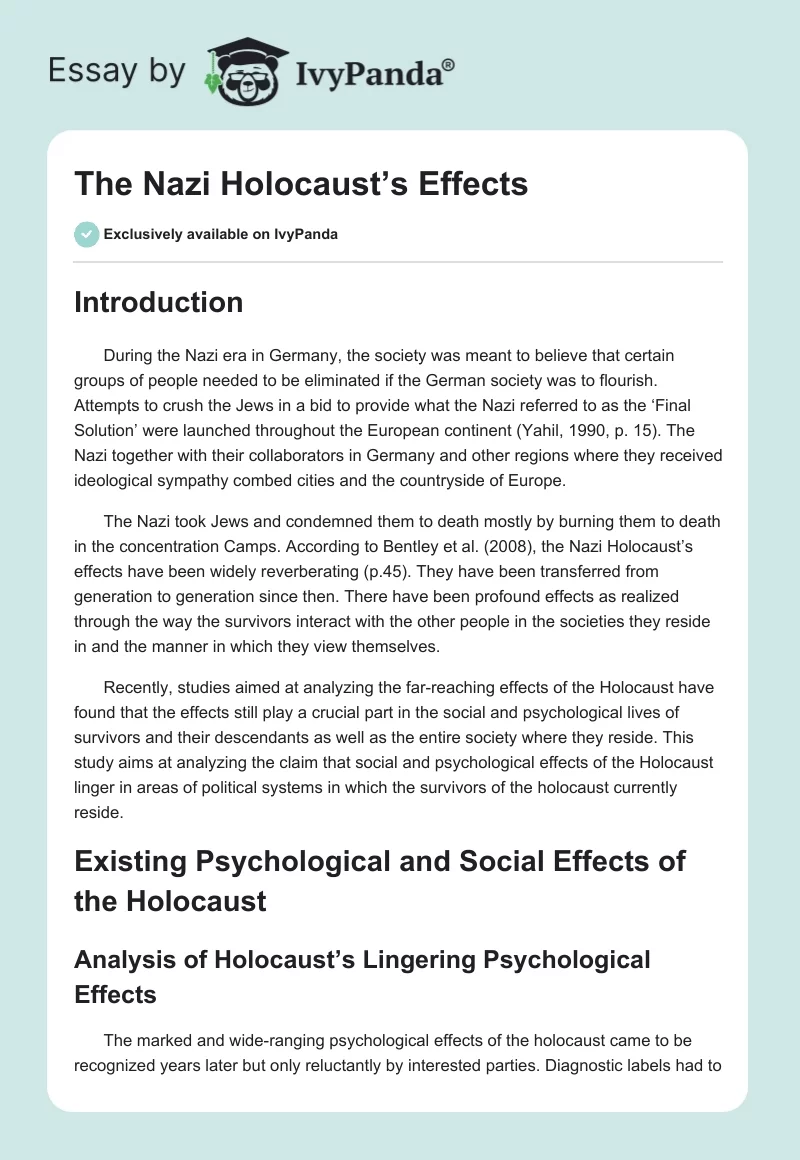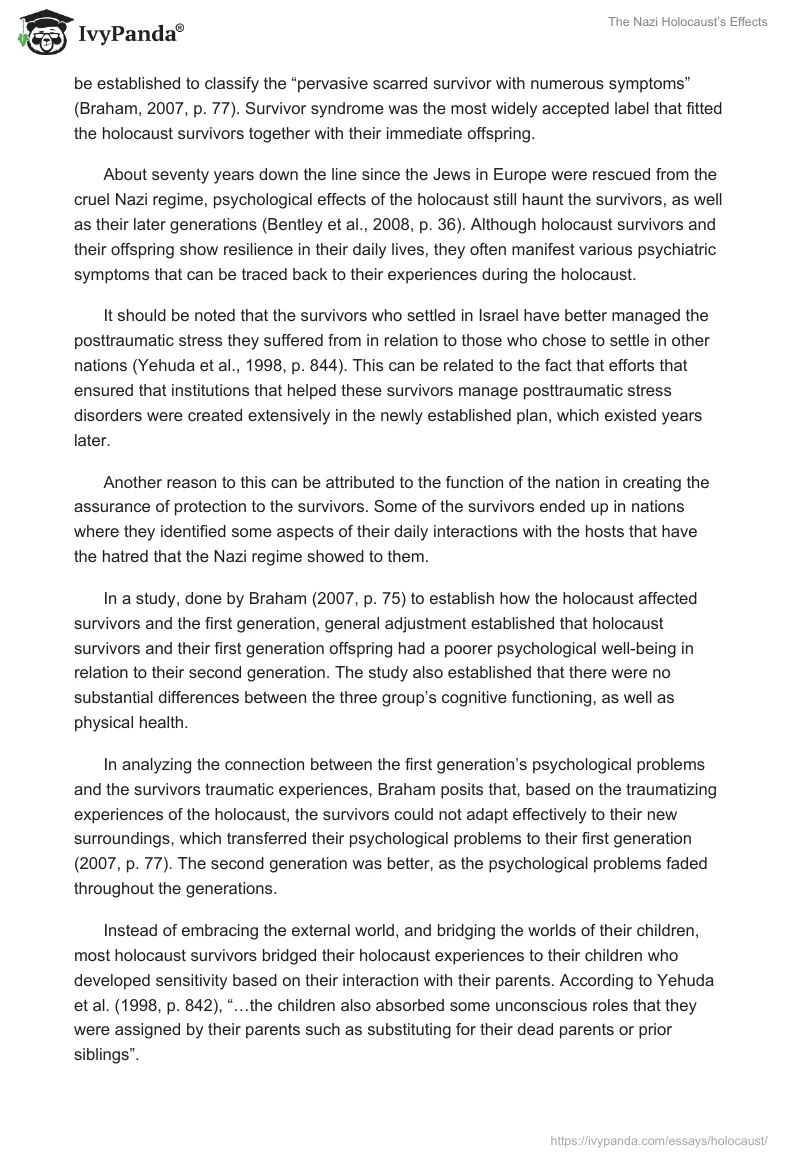Introduction
During the Nazi era in Germany, the society was meant to believe that certain groups of people needed to be eliminated if the German society was to flourish. Attempts to crush the Jews in a bid to provide what the Nazi referred to as the ‘Final Solution’ were launched throughout the European continent (Yahil, 1990, p. 15). The Nazi together with their collaborators in Germany and other regions where they received ideological sympathy combed cities and the countryside of Europe.
The Nazi took Jews and condemned them to death mostly by burning them to death in the concentration Camps. According to Bentley et al. (2008), the Nazi Holocaust’s effects have been widely reverberating (p.45). They have been transferred from generation to generation since then. There have been profound effects as realized through the way the survivors interact with the other people in the societies they reside in and the manner in which they view themselves.
Recently, studies aimed at analyzing the far-reaching effects of the Holocaust have found that the effects still play a crucial part in the social and psychological lives of survivors and their descendants as well as the entire society where they reside. This study aims at analyzing the claim that social and psychological effects of the Holocaust linger in areas of political systems in which the survivors of the holocaust currently reside.
Existing Psychological and Social Effects of the Holocaust
Analysis of Holocaust’s Lingering Psychological Effects
The marked and wide-ranging psychological effects of the holocaust came to be recognized years later but only reluctantly by interested parties. Diagnostic labels had to be established to classify the “pervasive scarred survivor with numerous symptoms” (Braham, 2007, p. 77). Survivor syndrome was the most widely accepted label that fitted the holocaust survivors together with their immediate offspring.
About seventy years down the line since the Jews in Europe were rescued from the cruel Nazi regime, psychological effects of the holocaust still haunt the survivors, as well as their later generations (Bentley et al., 2008, p. 36). Although holocaust survivors and their offspring show resilience in their daily lives, they often manifest various psychiatric symptoms that can be traced back to their experiences during the holocaust.
It should be noted that the survivors who settled in Israel have better managed the posttraumatic stress they suffered from in relation to those who chose to settle in other nations (Yehuda et al., 1998, p. 844). This can be related to the fact that efforts that ensured that institutions that helped these survivors manage posttraumatic stress disorders were created extensively in the newly established plan, which existed years later.
Another reason to this can be attributed to the function of the nation in creating the assurance of protection to the survivors. Some of the survivors ended up in nations where they identified some aspects of their daily interactions with the hosts that have the hatred that the Nazi regime showed to them.
In a study, done by Braham (2007, p. 75) to establish how the holocaust affected survivors and the first generation, general adjustment established that holocaust survivors and their first generation offspring had a poorer psychological well-being in relation to their second generation. The study also established that there were no substantial differences between the three group’s cognitive functioning, as well as physical health.
In analyzing the connection between the first generation’s psychological problems and the survivors traumatic experiences, Braham posits that, based on the traumatizing experiences of the holocaust, the survivors could not adapt effectively to their new surroundings, which transferred their psychological problems to their first generation (2007, p. 77). The second generation was better, as the psychological problems faded throughout the generations.
Instead of embracing the external world, and bridging the worlds of their children, most holocaust survivors bridged their holocaust experiences to their children who developed sensitivity based on their interaction with their parents. According to Yehuda et al. (1998, p. 842), “…the children also absorbed some unconscious roles that they were assigned by their parents such as substituting for their dead parents or prior siblings”.
The children felt overburdened and often overprotected by their parents, but could not resolve to be assertive considering the fact that they understood the fragility of their parents who required a show of compassion and understanding. This contributed to transfer of the psychological implications of the holocaust from one generation to the next.
The holocaust survivors who settled in countries that are relatively unstable politically suffer problems that are even more psychological emanating from their traumatizing experiences in the hands of the Nazi (Yahil, 1990, p. 33).
Their children were also affected by this considering that they were constantly reminded of the horrors by experiencing or observing the happenings in their current environment. Some phobia exists in these generations, as they connect the violence and instability with the effects that their ancestors experienced in the Nazi regime.
However, the psychological scars the holocaust survivors or their offspring suffer have not substantially affected their abilities to cope with events of their day-to-day lives. This is the principal reason why people tend to believe that the psychological effects of the holocaust have entirely disappeared with time. Although they are not as adverse as they were, the psychological effects of the holocaust affect subsequent generations of Jews, Gypsies and others wherever they are currently residing.
Analysis of Lingering social effects of the Holocaust
The hatred and prejudice that fuelled the Holocaust was intertwined with the political agenda, which dominated the Nazi regime. According to the aggression theory, Hitler thought the Jews were responsible for the loss of the World War I, and sought to solve the Jewish question with what the Nazi regarded as the ‘Final Solution’ (Whealey, 2011, p. 763).
Instead of targeting the aspects of the Jewish community, as well as in other instances, the gypsies directed his aggression upon the entire community creating ideologies that aided him in creating sympathizers throughout the European continent.
With the help of the anti-Semitism prejudice that existed in Germany for a long time, Hitler managed to garner sympathizers in Germany and other parts of the European continent where the Nazi had influence (Whealey, 2011, p. 764). Together with these sympathizers and fellow Nazis, Hitler carried out one of the grievous genocide in the history of the world.
In several incidences during the years that the Nazi party ruled Germany, thousands of Jews and other groups were mercilessly burned to death in the concentration camps that spread throughout Europe. Almost two thirds of the existing Jewish population in Europe lost their lives as victims of these atrocities.
As evidenced by the resurgence of anti-Semitism in the aftermath of the Nazi regime and the Second World War, the social and police effects of the holocaust affected the lives of the holocaust survivors, as well as their subsequent generations throughout the world, where they ended up settling. The social implications of the holocaust were mostly experienced by the actual victims of the atrocities more than the other Jews who resided in other more tolerable regions as revealed through a study carried out by Williams (2010, p. 79).
The study relates the social implications of the holocaust on the survivors in relation to the other Jews who resided in other nations. The study uses a sample of holocaust survivors currently residing in the US, and compares them with another Jewish control group comprised of Jews who resided in the US during the time of the holocaust. The study reveals that the Jewish holocaust survivors are reluctant to participate in social activities compared to the control group.
The holocaust survivors living outside the Israel nation portrayed aspects of the “survivor syndrome”, which was often marked with the fear to participate in social and even political activities. A phobia in collective activities is a social implication still portrayed by the survivors of the holocaust.
However, this does not reveal itself in the second generation of the survivors according to Braham (2007, p.73). This means that the later offspring of the survivors are breaking from some of the social and psychological effects of the holocaust that their parents and prior generations portray.
Comparatively, a similar study conducted in Israel reveals that such a problem does not exist even among the survivors of the holocaust and even their descendants. The establishment of social institutions aimed at addressing the social implications of the holocaust has succeeded in achieving the same.
Braham’s study also found out that the Jewish holocaust survivors residing in both Israel and the United states currently face life with more optimism compared to their counterparts who chose to remain in nations such as Germany and Poland (2007, p. 76). This narrows down to their worldviews and the associations they make out of the institutions that caused them grievous social and psychological agony for years. They, in fact, took the longest time to show progress in recovering from the effects of the holocaust.
Conclusion
While studies carried out to establish the existence of the implications of the holocaust in present day world prove that they exist, it should be noted that the magnitude of such implications is reducing with time.
There were higher rates of psychological breakdowns in the years after the Jews were saved from the cruelty of the Nazi regime during that time as compared to the present. Psychologically troubled survivors, as well as the anti-social behaviors among the Jewish survivors in the different countries, can argue this by considering the deaths because of suicide they sought refuge after the experiences.
Even children committed suicide because of posttraumatic stress and associated complications in the 1950s and 60s (Whealey, 2011, p. 765). Although such adverse social and psychological effects of the holocaust among the survivors and their offspring are rare, the effects of the holocaust caused long-lasting social and psychological effects that still linger in the societies. They can even be noticed through studying the social and psychological behaviors of these survivors.
References
Bentley, J., Ziegler, H., & Streets, H. (2008). Traditions & encounters: A brief global history (3rd ed.). New York: McGraw Hill.
Braham, R. (2007). The Psychological Perspectives of the Holocaust and of its Aftermath Forty Years Later. New York: Columbia University Press.
Whealey, R. (2011). Historians of the Jews and the Holocaust. Canadian Journal of history, 46(3), 763-766.
Williams, S. (2010). The socio-political impacts of the Holocaust on survivors and their later generations. Journal of European History, 2(1), 73-85.
Yahil, L. (1990). The Holocaust: The Fate of European Jewry, 1932-1945. New York: Oxford University Press.
Yehuda, R., Schmeidler, J., Giller, E., Siever, L., & Binder-Byrnes, K. (1998). Relationship
between posttraumatic stress disorder characteristics of Holocaust survivors and their adult offspring. American Journal of Psychiatry, 155(6), 841-844.


